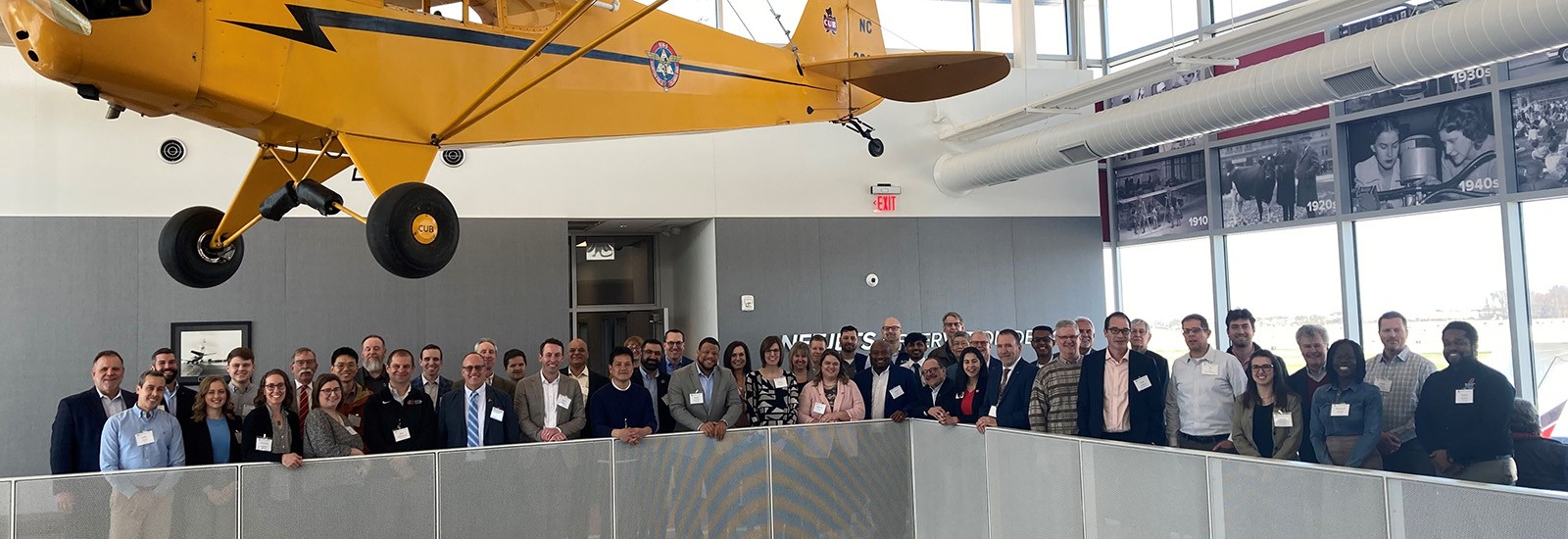Significant investments will be needed to help the aviation sector transition to a low-carbon future and partnerships among business, government and academia will be critical to overcoming obstacles along the way. These were among the observations shared during a forum this spring hosted by The Ohio State University that brought together researchers, industry leaders, and government officials to discuss decarbonization of the industry.
Speakers highlighted the required advances in aircraft design and propulsion, infrastructure and ground systems to support novel sources of power, and workforce development necessary to build and maintain a new generation of air transportation.
Some of the most promising pathways to reduce aviation’s carbon footprint involve innovations in aircraft design and propulsion systems. For instance, sustainable aviation fuel made from renewable biomass and waste could contribute upwards of 60% of the emissions reductions that the industry will need to reach net-zero by 2050.
Panelists from GE Aerospace and Honda Aircraft shared that their companies have demonstrated that existing engines can operate using this biofuel. Yet, scaling up production remains challenging and expensive.
GE Aerospace is also investing in demonstrations of other engine technologies including open fan architecture, hybrid electric propulsion, and hydrogen combustion. A panelist from Textron described his division’s focus on all-electric engines for the company’s lighter aircraft. This pathway avoids the concern of high fuel prices, especially for sustainable aviation fuel, but is limited by current battery technologies.
Ground operations are another source of greenhouse gas emissions for the aviation industry. Decarbonizing infrastructure is a “wicked” problem with many complex and interdependent considerations including cost of upgrades, available space, public safety and environmental justice impacts.
For instance, upgrading heliports on buildings for electric aircraft raises logistical questions about getting power for rapid charging to the rooftop. Firefighters would also need to adapt since traditional methods of using foam do not work for electric fires. Working through a coalition that includes stakeholders from the community, business, and local authorities is one way to address multiple issues that cut across many segments of society.
An exciting pathway to decarbonization envisions the airport of tomorrow that can handle the needs of low-carbon aircraft while operating more sustainably. At the forum, a team of Ohio State aerospace engineering students presented their design for a new international airport that took second place in a national competition held by NASA.
The design incorporated elements to accommodate expected increases in the use of sustainable aviation fuel, the installation of charging stations, and even new systems to store and dispense liquid hydrogen. The students took a deep dive into the sustainability of airport construction, recommending mass timber materials, electrochromic windows, and on-site renewables. They also proposed the use of electric autonomous ground support equipment, which require less energy and maintenance.
Beyond technological advances, people will underpin the success of decarbonization efforts. A final forum panel explored the implications of a transition to low-carbon aviation for the industry’s workforce.
Preparing the workforce for changes that are still being developed is difficult but speakers from Boeing and GE Aerospace named several current needs. For instance, well-rounded engineers who understand data analytics and can use augmented reality/virtual reality will be in demand. Importantly, there continue to be opportunities to increase diversity within the aviation workforce, especially by exposing students early on to educational and career paths in the field.
The pathways to aviation decarbonization are varied and each has significant challenges. Public-private partnerships that involve academic institutions like Ohio State are critical to overcoming obstacles.
“Ohio State is ready to help aviation meet its sweeping sustainability commitments,” said Dororta Grejner-Brzezinska, Vice President of Knowledge Enterprise.
The university is interested in partnering with businesses, government agencies and community stakeholders to develop the breakthroughs needed to make the transition to net zero. For more information about partnership opportunities, please contact Josh Knights.
The event was the second sustainable aviation forum hosted by Ohio State. It was organized by faculty and staff from the Aerospace Research Center, the Center for Automotive Research, the Center for Aviation Studies, the College of Engineering, The Ohio State University Airport, and the Sustainability Institute. Financial support for the program was provided by Honda.
Read the Ohio State Forum on Transitioning to Low-Carbon Aviation report.
Story by Nathan Chaykowski, Sustainability Institute Student Business Development Assistant
